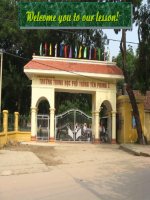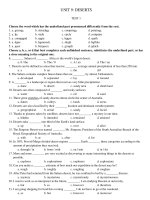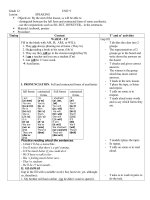unit 9 . lop 12cb
Bạn đang xem bản rút gọn của tài liệu. Xem và tải ngay bản đầy đủ của tài liệu tại đây (63.6 KB, 10 trang )
UNIT 9: DESERTS
TEST 1
Choose the word which has the underlined part pronounced differently from the rest.
1. a. grasses b. stretches c. comprises d. potatoes
2. a. lie b. wide c. circle d. comprise
3. a. compound b. route c. house d. south
4. a. dune b. hummock c. shrub d. buffalo
5. a. west b. between c. growth d. which
Choose a, b, c, or d that best completes each unfinished sentence, substitutes the underlined part, or has
a close meaning to the original one.
6. ________ Sahara of ________ Africa is the world's largest desert.
a. 0 / the b. The / 0 c. A / an d. The / an
7. Deserts can be defined as areas that receive ________ average annual precipitation of less than 250 mm.
a. a b. an c. the d.0
8. The Sahara contains complex linear dunes that are ________ by almost 6 kilometers.
a. developed b. separated c. lay d. located
9. A ________ is a landscape or region that receives very little precipitation.
a. dune b. desert c. sandy area d. shrub land
10. Deserts are often composed of ________ and rocky surfaces.
a. water b. trees c. oil d. sand
11. Three great stretches of sandy deserts almost circle the center of Australia.
a. dunes b. valleys c. lands d. areas
12. Deserts are also classified by their ________ location and dominant weather pattern.
a. geographical b. aerial c. sandy d. facial
13. Thanks to pictures taken by satellites, deserts have not ________ a mystery in our time.
a. hidden b. intended c. remained d. attained
14. Deserts take ________ one-third of the Earth's land surface.
a. up b. on c. over d. after
15. The Simpson Desert was named ________ Mr. Simpson, President of the South Australian Branch of the
Royal Geographical Society of Australia.
a. with b. at c. after d. for
16. In 1953, Peveril Meigs divided desert regions ________ Earth ________ three categories according to the
amount of precipitation they received.
a. through / in b. from / with c. on / into d. in / for
17. More and more ________ are very excited at discovering as many interesting things in the deserts as
possible.
a. explores b. explorations c. explorers d. exploratory
18. Can you make a ________ estimate of how much our expedition in the desert may be?
a. rough b. roughly c. roughing d. roughen
19. After Peter had returned from the Sahara desert, he was confined to bed by a ________ disease.
a. mystery b. mysterious c. mysteriously d. mysteriousness
20. I want to work as an interpreter in the future, ________, I am studying Russian at university.
a. but b. so c. however d. therefore
21. I am going shopping for food this evening ________ I do not have to go at the weekend.
a. so b. but c. however d. moreover
22. When she got the news from her family, she could not do anything, ________ cry.
a. but b. and c. so d. however
23. Mrs. Lindon has ________ that she is unable to get a job.
a. but not enough education b. so little education
c. however little education d. such little education
24. That small car, ________, is advertised in many current magazines.
a. so inexpensive and comfortable b. however inexpensive and comfortable
c. inexpensive but comfortable d. and inexpensive but comfortable
25. We live in the same building ________ we have hardly seen each other
a. and b. therefore c. but d. so
26. I went to buy a Rolling Stones CD ________ the shop didn't have it.
a. and b. but c. therefore d. so
27. Anna needed some money, ________, she took a part-time job.
a. furthermore b. moreover c. however d. therefore
28. Julie has a guitar ________ she plays it really well.
a. and b. so c. but d. therefore
29. My fingers were injured ________ my sister had to write the note for me.
a. and b. however c. so d. but
30. The concert was cancelled ________ we went to a nightclub instead.
a. so b. however c. so on d. but
Error Identification.
31. Desert is (A) a large area of land (B) that has very little water (C) however very few plants (D) growing on
it.
32. Rain (A) falls occasionally in deserts (B) so desert storms (C) are often violent.
33. The Nile River, the Colorado River, (A) but the Yellow River flow (B) through deserts (C) to deliver their
sediments (D) to the sea.
34. Deserts (A) may have underground springs, rivers, or reservoirs (B) they lie close to (C) the surface, (D) or
deep underground.
35. (A) Most plants in deserts (B) have adapted to sporadic (C) rainfalls in a desert (D) environments.
Read the passage carefully and choose the correct answer.
A desert is a hostile, potentially deadly environment for unprepared humans. In hot deserts, high
temperatures cause rapid loss of water due to sweating, and the absence of water sources with which to
replenish it can result in dehydration and death within a few days. In addition, unprotected humans are also at
risk from heatstroke.
Humans may also have to adapt to sandstorms in some deserts, not just in their adverse effects on
respiratory systems and eyes, but also in their potentially harmful effects on equipment such as filters, vehicles
and communication equipment. Sandstorms can last for hours, sometimes even days.
Despite this, some cultures have made hot deserts their home for thousands of years, including the
Bedouin, Tuareg tribe, and Pueblo people. Modern technology, including advanced irrigation systems,
desalinization and air conditioning, has made deserts much more hospitable. In the United States and Israel for
example, desert farming has found extensive use.
In cold deserts, hypothermia and frostbite are the chief hazards, as well as dehydration in the absence of
a source of heat to melt ice for drinking. Falling through pack-ice or surface ice layers into freezing water is a
particular danger requiring emergency action to prevent rapid hypothermia. Starvation is also a hazard; in low
temperatures the body requires much more food energy to maintain body heat and to move. As with hot deserts,
some people such as the Inuit have adapted to the harsh conditions of cold deserts.
36. The text is about ________.
a. troubles that human beings have to face in a desert
b. desert storms and desert inhabitants
c. hot deserts and cold deserts in the United States
d. desert hospitality and environment
37. Which is not a problem for an unprepared man in a hot desert?
a. sandstorm b. loss of water c. irrigation d. heatstroke
38. Sandstorms ________.
a. do no harm to machinery
b. have effects only on the eyes
c. never lasts more than one hour
d. have bad effects on both human beings and machinery
39. Which sentence is true?
a. No one can survive in both hot and cold deserts.
b. Modern technology makes deserts more hospitable.
c. In the United States, all deserts are quite uninhabited.
d. There are no deserts in Israel.
40. Which is not a problem in cold deserts?
a. Starvation b. Hypothermia c. Frostbite d. Body heat
Fill in each numbered blank with one suitable word or phrase.
Desert biomes are the (41) ________ of all the biomes. In fact, the most important characteristic of a
desert is that it receives very little (42) ________. Most deserts receive less than 300 mm a year compared (43)
________ rainforests, which receive over 2,000 mm. That means that the desert only gets 10 percent of the rain
that a rainforest gets! The temperature in the desert can (44) ________ drastically from day to night because the
air is (45) ________ dry that heat escapes rapidly at night. The daytime temperature averages 38 ·C (46)
________ in some deserts it can get down to -4 ·C at night. The temperature also varies greatly depending on
the (47) ________ of the desert.
Since desert conditions are so severe, the plants that live there need to have (48) ________ to
compensate for the lack of water. Some plants, such as cacti, (49) _______ water in their stems and use it very
slowly, while others like bushes conserve water by growing few leaves or by having large root systems to
gather water or few leaves. Some desert plant species have a short life cycle of a few weeks that (50) _______
only during periods of rain.
41. a. coldest b. hottest c. driest d. wettest
42. a. rain b. rainfall c. raindrop d. raincoat
43. a. with b. for c. about d. in
44. a. change b. exchange c. transform d. transfer
45. a. such as b. such c. so much d. so
46. a. when b. while c. as d. because
47. a. part b. region c. area d. location
48. a. adaptations b. agreements c. accepts d. achievements
49. a. place b. put c. store d. hold
50. a. spend b. take c. last d. experience
TEST 2
Choose the word which is stressed differently from the rest.
1. a. comprise b. sandy c. circle d. northern
2. a. Aborigines b. expedition c. kilometer d. scientific
3. a. corridor b. enormous c. mystery d. separate
4. a. remain b. hummock c. explore d. between
5. a. territory b. Australia c. geography d. society
Choose a, b, c, or d that best completes each unfinished sentence, substitutes the underlined part, or has
a close meaning to the original one.
6. The Simpson Desert is in ________ north of ________ Lake Eyre.
a. 0 / 0 b. the / the c. a / the d. the / 0
7. Cold deserts can be covered in ________ snow or ice and frozen water is unavailable to plant life.
a. a b. an c. the d. 0
8. In the northern part of the Simpson Desert, the dunes are separated by ________ of low, open shrubland.
a. streets b. ways c. corridors d. lines
9. San Francisco is built on 40 hills and some are very ________.
a. short b. steep c. plain d. stable
10. A ________ is a small raised area of ground, like a very small hill.
a. slope b. hummock c. dune d. shrub
11. We used to climb up the crest of the hill to get a good view of the surroundings.
a. top b. foot c. middle d. face
12. To ________ a desert is a danger activity which requires careful preparation for risks.
a. comprise b. circle c. remain d. explore
13. Scientific ________ help to explore some places and discover more and more remote parts of the world.
a. survey b. lead c. research d. expedition
14. The wind that blows in the desert comes ________ far away waters.
a. for b. with c. in d. from
15. Some sand dunes may be over 200 meters ________ height.
a. with b. at c. on d. in
16. If you look on a map you will see that there is a desert next ________ the Rocky Mountains in the United
States.
a. of b. to c. with d. for
17. ________ is the process by which a piece of land becomes dry, empty, and unsuitable for growing trees or
crops on.
a. desert b. deserted c. desertify d. desertification
18. Several ________ advanced countries have had plans to make desert more hospitable.
a. science b. scientific c. scientifically d. scientist
19. The desert biome includes the hottest places in the world because it absorbs more ________ from the sun
than land in humid climates do.
a. heat b. hot c. hotly d. heating
20. Many people have law degrees, ________.
a. but some of them do not practice it b. however it is not practiced by all
c. so some are not practicing law d. but not all of them practice law
21. This is an expensive ________ very useful book.
a. but b. so c. therefore d. however
22. ________ long it takes, I will wait for you.
a. However b. But c. So d. Therefore
23. I must say that you have done very well. ________, you should be aware that you still have a lot of thing to
learn.
a. Therefore b. So c. But d. However
24. ________ that we stopped for a rest.
a. But we were tired b. So tired were we
c. However we were tired d. Therefore, we were tired
25. He is only sixteen, and ________, he is not eligible to drive a car.
a. nevertheless b. but c. therefore d. however
26. Maria tried to read a novel in French ________ the book was too difficult for her to understand.
a. so that b. therefore c. but d. and
27. To get from Vancouver to Victoria, you can fly, ________ you can ride the ferry.
a. or b. but c. so d. however
28. I bought a bottle of wine ________ we drank it together.
a. therefore b. so c. and d. but
29. The waiter was not very nice, ________ , the food was delicious.
a. however b. but c. so d. and so
30. ________ hard he worked, he could earn enough money to support the family.
a. But b. However c. Therefore d. Whatever
Choose the sentence which has the closest meaning to the original one.
31. Slippery as the roads were, they managed to complete the race.
a. The roads were so slippery that they could hardly complete the race.
b. The roads were slippery but they managed to complete the race.
c. The roads were slippery so they could hardly complete the race.
d. The roads were so slippery, therefore, they could hardly complete the race,
32. They decided to go for a picnic though it was very cold.
a. Because it was very cold, they decided to go for a picnic.
b. However cold it was, they decided to go for a picnic.
c. If it had been cold, they would not have gone for a picnic.
d. It was very cold so they decided to go for a picnic.
33. Both Peter and Mary enjoy scientific expedition.
a. It is not Peter, but Mary, that enjoys scientific expedition.
b. Peter enjoys scientific expedition. Therefore, does Mary.
c. However Peter enjoys scientific expedition, and Mary does.
d. Peter enjoys scientific expedition, and so does Mary.
34. Because it was an interesting novel, I stayed up all night to finish it.
a. I stayed up all night to finish the novel, therefore, it was interesting.
b. Unless it were an interesting novel, I would stay up all night to finish it.
c. Though it was an interesting novel, I stayed up all night to finish it.
d. So interesting was the novel that I stayed up all night to finish it.
35. He cannot afford a new computer.
a. The new computer is so expensive that he cannot buy it.
b. Therefore, he would buy a new computer.
c. So, he would buy a new computer.
d. The new computer is so expensive but he can buy it









